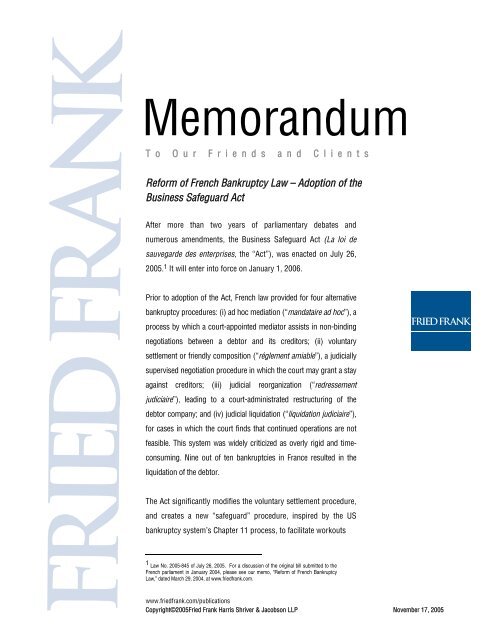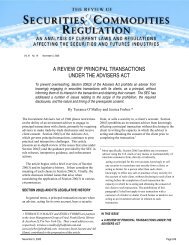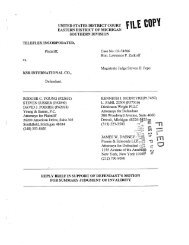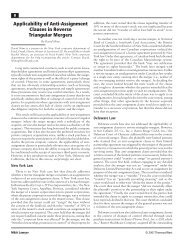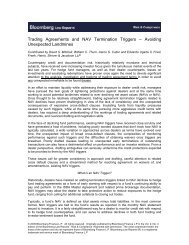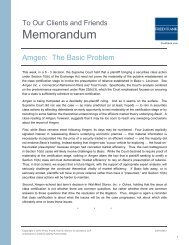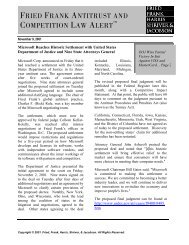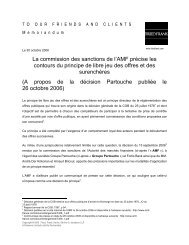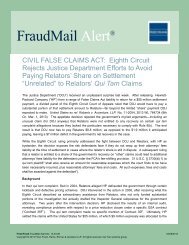Reform of French Bankruptcy Law - Fried Frank
Reform of French Bankruptcy Law - Fried Frank
Reform of French Bankruptcy Law - Fried Frank
You also want an ePaper? Increase the reach of your titles
YUMPU automatically turns print PDFs into web optimized ePapers that Google loves.
Memorandum<br />
T o O u r F r i e n d s a n d C l i e n t s<br />
<strong>Reform</strong> <strong>of</strong> <strong>French</strong> <strong>Bankruptcy</strong> <strong>Law</strong> – Adoption <strong>of</strong> the<br />
Business Safeguard Act<br />
After more than two years <strong>of</strong> parliamentary debates and<br />
numerous amendments, the Business Safeguard Act (La loi de<br />
sauvegarde des enterprises, the “Act”), was enacted on July 26,<br />
2005. 1 It will enter into force on January 1, 2006.<br />
Prior to adoption <strong>of</strong> the Act, <strong>French</strong> law provided for four alternative<br />
bankruptcy procedures: (i) ad hoc mediation (“mandataire ad hoc”), a<br />
process by which a court-appointed mediator assists in non-binding<br />
negotiations between a debtor and its creditors; (ii) voluntary<br />
settlement or friendly composition (“réglement amiable”), a judicially<br />
supervised negotiation procedure in which the court may grant a stay<br />
against creditors; (iii) judicial reorganization (“redressement<br />
judiciaire”), leading to a court-administrated restructuring <strong>of</strong> the<br />
debtor company; and (iv) judicial liquidation (“liquidation judiciaire”),<br />
for cases in which the court finds that continued operations are not<br />
feasible. This system was widely criticized as overly rigid and timeconsuming.<br />
Nine out <strong>of</strong> ten bankruptcies in France resulted in the<br />
liquidation <strong>of</strong> the debtor.<br />
The Act significantly modifies the voluntary settlement procedure,<br />
and creates a new “safeguard” procedure, inspired by the US<br />
bankruptcy system’s Chapter 11 process, to facilitate workouts<br />
1 <strong>Law</strong> No. 2005-845 <strong>of</strong> July 26, 2005. For a discussion <strong>of</strong> the original bill submitted to the<br />
<strong>French</strong> parliament in January 2004, please see our memo, “<strong>Reform</strong> <strong>of</strong> <strong>French</strong> <strong>Bankruptcy</strong><br />
<strong>Law</strong>,” dated March 29, 2004, at www.friedfrank.com.<br />
www.friedfrank.com/publications<br />
Copyright©2005<strong>Fried</strong> <strong>Frank</strong> Harris Shriver & Jacobson LLP November 17, 2005
early in the bankruptcy process and avoid liquidation where possible. The Act also streamlines the sale <strong>of</strong><br />
companies in liquidation, and institutes a simplified liquidation procedure for small debtors. 2 Together,<br />
these provisions amount to a significant reform <strong>of</strong> the <strong>French</strong> bankruptcy system.<br />
1. Ad Hoc Mediation<br />
Ad hoc mediation is a common procedure, in which the president <strong>of</strong> the Commercial Court names a<br />
mediator, upon application <strong>of</strong> the debtor, to resolve specified re-financing issues. This procedure is flexible<br />
and informal, and has been only lightly modified by the Act.<br />
The ad hoc mediation procedure is not available to a debtor that has ceased payments. Traditionally, in<br />
light <strong>of</strong> the drastic consequences <strong>of</strong> more formal bankruptcy procedures, it has been used to prepare for a<br />
voluntary composition with creditors (known as a “réglement amiable”) or to stave <strong>of</strong>f bankruptcy.<br />
While the mediator is appointed by the court, in practice the debtor <strong>of</strong>ten recommends a pr<strong>of</strong>essional who<br />
is already familiar with the debtor’s financial situation. The mediator’s mandate is determined by the court<br />
and is intended to facilitate an agreement between the debtor and its creditors. The entire procedure is<br />
confidential.<br />
2. The Conciliation Procedure<br />
Under the Act, the voluntary settlement procedure has been modified and renamed “conciliation.” This<br />
procedure will be available to any company that faces legal, economic or financial difficulties, currently or<br />
in the foreseeable future, or that has ceased payments for no longer than 45 days. Conciliation is intended<br />
to permit the debtor and its creditors to arrive at a mutually acceptable compromise on a contractual basis.<br />
Conciliation is intended to be a brief, four-month process, renewable for one month, supervised by the<br />
Commercial Court <strong>of</strong> the debtor’s jurisdiction. The president <strong>of</strong> the Commercial Court will appoint a<br />
mediator who will negotiate agreements with creditors and who will have broad authority to propose plans<br />
for restructuring the business and retaining employees. The debtor company may recommend potential<br />
mediators for the court’s approval, as well as appeal the court’s choice <strong>of</strong> a mediator. 3<br />
An agreement between the debtor and its creditors reached in the context <strong>of</strong> a conciliation procedure must<br />
be approved by the court, which will then become binding on all parties to the agreement.<br />
2 Unlike the current bankruptcy system, this is applicable to both corporations and pr<strong>of</strong>essionals in private practice.<br />
3 <strong>French</strong> Commercial Code, Art. L. 611-6. The procedures for appealing a mediator’s appointment will be set out in a future implementing decree.<br />
<strong>Fried</strong>, <strong>Frank</strong>, Harris, Shriver & Jacobson LLP Client Memorandum November 17, 2005 2<br />
A Delaware Limited Liability Partnership
The draft reform bill submitted to the <strong>French</strong> parliament in 2004 provided that the ratification <strong>of</strong> a<br />
conciliation agreement by the court would be made public. This position evoked fierce opposition on the<br />
grounds that publicity <strong>of</strong> a court’s ratification order could alarm a business’s suppliers and clients. Under<br />
the Act, the ratification order will be published only at the request <strong>of</strong> the debtor, and only if creditors not<br />
parties to the agreement are not prejudiced by the conciliation agreement.<br />
There is a significant new advantage <strong>of</strong>fered under the Act in the case <strong>of</strong> a published conciliation order:<br />
credit extended to a debtor during the conciliation procedure will benefit from a higher priority than claims<br />
arising prior to the commencement <strong>of</strong> the conciliation procedure. Security granted under such<br />
arrangements will not be open to challenge as fraudulent conveyances. 4 The protection afforded to such<br />
new credit will likely lead creditors to push for publication <strong>of</strong> the conciliation order in most cases.<br />
The commencement <strong>of</strong> a conciliation procedure will not automatically stay creditors’ claims. However, in<br />
an action for payment against the debtor, any court may grant the debtor a deferral or extension <strong>of</strong><br />
payments and suspend enforcement actions brought by creditors. 5 In addition, court approval <strong>of</strong> a<br />
conciliation agreement will suspend any ongoing legal actions against the debtor brought by creditors who<br />
are parties to the agreement.<br />
3. The Safeguard Procedure<br />
The Act introduces a completely new procedure, referred to as the “safeguard” (“sauvegarde”) procedure,<br />
intended to facilitate the restructuring <strong>of</strong> a debtor company before its financial difficulties become<br />
irremediable. Similar to a US bankruptcy case, the commencement <strong>of</strong> a safeguard procedure will result in<br />
an automatic stay against creditors in favor <strong>of</strong> the debtor and guarantors or joint obligors <strong>of</strong> the debtor. 6<br />
The safeguard procedure is intended to lead to a continuation plan and cannot entail the sale <strong>of</strong> the debtor<br />
company as a whole. The plan may provide for the modification <strong>of</strong> the debtor’s capital structure, an<br />
adjustment <strong>of</strong> its liabilities, the division <strong>of</strong> the debtor corporation into autonomous entities, asset sales, and<br />
sales <strong>of</strong> corporate divisions. 7 The court may also make adoption <strong>of</strong> the plan conditional on a change in the<br />
debtor’s management or directors. 8 The duration <strong>of</strong> a safeguard procedure is six months, with the<br />
possibility <strong>of</strong> one six-month extension. 9<br />
4 <strong>French</strong> Commercial Code, Art. L. 631-8.<br />
5 <strong>French</strong> Civil Code, Arts. 1244-1 and 1244-2.<br />
6 <strong>French</strong> Commercial Code, Art. L. 622-28.<br />
7 <strong>French</strong> Commercial Code, Art. L. 626-1 and 626-3.<br />
8 <strong>French</strong> Commercial Code, Art. L. 626-4.<br />
9 Additional extensions may be possible, but the procedures for requesting and granting them have not yet been established, and will require an implementing decree.<br />
<strong>French</strong> Commercial Code, Art. L. 621-3.<br />
<strong>Fried</strong>, <strong>Frank</strong>, Harris, Shriver & Jacobson LLP Client Memorandum November 17, 2005 3<br />
A Delaware Limited Liability Partnership
During the safeguard procedure, payments by the debtor <strong>of</strong> any debts existing prior to the opening <strong>of</strong> the<br />
procedure are prohibited, except for those payments necessary for the business’s ordinary activities, and<br />
“for the requirements <strong>of</strong> the procedure.” 10 The bankruptcy judge can also authorize payments for prior<br />
debts in order to discharge a lien on property needed for the continued operation <strong>of</strong> the business. 11<br />
Debts arising after the commencement <strong>of</strong> the safeguard procedure will be given priority over debts<br />
incurred prior to the commencement <strong>of</strong> the safeguard procedure if they relate to expenses necessary for<br />
the business’s ordinary activities or are “for the requirements <strong>of</strong> the procedure.” 12 This priority appears<br />
substantially more restrictive on its face than the new money priority in a conciliation procedure, which<br />
provides for a priority for all “new treasury provided to the debtor in order to enable the continuation <strong>of</strong> its<br />
activities and its survival.” 13<br />
The commencement <strong>of</strong> a safeguard procedure suspends the accumulation <strong>of</strong> interest and penalties, except<br />
for interest on loans with a term <strong>of</strong> one year or more. 14 Thus, longer-term bank debt and bonds may<br />
continue to accumulate interest, though payment <strong>of</strong> that interest will be prohibited until the end <strong>of</strong> the<br />
safeguard procedure.<br />
Similar to a US Chapter 11 case, the administrator in a safeguard action or a judicial liquidation has the<br />
sole authority to reject or continue commercial contracts, including unexpired leases, entered into prior to<br />
the commencement <strong>of</strong> the safeguard action. 15 Contracts are not automatically terminated by the<br />
commencement <strong>of</strong> the safeguard procedure and may not be terminated by the non-debtor party on the<br />
basis <strong>of</strong> the opening <strong>of</strong> a safeguard procedure or for failure by the debtor to perform the contract prior to<br />
the commencement <strong>of</strong> the safeguard procedure. 16 If the administrator rejects a contract, the other party<br />
may file a claim for damages. 17<br />
Unlike in the US, in a safeguard procedure the rules authorizing rejection <strong>of</strong> prior contracts do not extend<br />
to employment agreements, which remain subject to the normal <strong>French</strong> labor law regime. During the<br />
10 <strong>French</strong> Commercial Code, Art. L. 622-7.<br />
11 <strong>French</strong> Commercial Code, Art. L. 622-7.<br />
12 <strong>French</strong> Commercial Code, Arts. L. 622-17.<br />
13 <strong>French</strong> Commercial Code, Art. L. 611-11.<br />
14 <strong>French</strong> Commercial Code, Art. L. 622-28.<br />
15 <strong>French</strong> Commercial Code, Art. L. 622-13.<br />
16 Pursuant to Art. 431-7-2 <strong>of</strong> the <strong>French</strong> Monetary and Financial Code, some types <strong>of</strong> contracts are exempted from this rule, such as certain financial guarantees<br />
governed by Art. 431-7-1 <strong>of</strong> the <strong>French</strong> Monetary and Financial Code.<br />
17 <strong>French</strong> Commercial Code, Arts. L. 622-13 and 622-14.<br />
<strong>Fried</strong>, <strong>Frank</strong>, Harris, Shriver & Jacobson LLP Client Memorandum November 17, 2005 4<br />
A Delaware Limited Liability Partnership
parliamentary debate on the Act, a provision was proposed that would have allowed expedited lay<strong>of</strong>fs<br />
during a safeguard procedure. This aroused strong objections and, as a result, was not included in the Act.<br />
In a safeguard procedure, judicial reorganization, or judicial liquidation, employee wage claims have an<br />
absolute priority over all other claims, followed, in order <strong>of</strong> priority, by administrative expenses, the<br />
privilege for any new money extended in a previous conciliation procedure, and certain claims arising after<br />
commencement <strong>of</strong> the safeguard procedure, as discussed above. 18 By contrast, in the US, wage claims<br />
earned within 180 days <strong>of</strong> the earlier <strong>of</strong> either the date the bankruptcy petition is filed or the date <strong>of</strong><br />
cessation <strong>of</strong> the debtor’s business are given a fourth-level priority over other unsecured claims only up to<br />
an amount <strong>of</strong> $10,000 per employee, and are subordinated in priority to administrative expenses <strong>of</strong> the<br />
bankruptcy procedure, as well as certain other unsecured creditors’ claims arising after the bankruptcy<br />
filing. 19<br />
Scope <strong>of</strong> the safeguard procedure<br />
The safeguard procedure will be available for debtors meeting the following criteria:<br />
- The company must be facing serious difficulties. The term “difficulties” is not defined in the Act,<br />
but will likely be interpreted broadly to include economic, legal, financial or labor-related<br />
difficulties.<br />
- The company finds it impossible to surmount those difficulties, because <strong>of</strong> inadequate financing.<br />
- The company has not yet suspended payments, but will inevitably do so as a result <strong>of</strong> its<br />
difficulties. 20 The Act does not specify a timeframe for evaluating the imminence <strong>of</strong> a suspension<br />
<strong>of</strong> payments, but the probability <strong>of</strong> insolvency must be demonstrable; i.e., the court may require<br />
pro<strong>of</strong> that when existing debts come due, the company will not be able to pay.<br />
So long as the company has not yet ceased payments, the company’s managers can choose between the<br />
conciliation and safeguard procedures. This decision will turn on a number <strong>of</strong> factors: the conciliation<br />
procedure is rapid and can be kept confidential, but does not result in a stay against creditors, while the<br />
safeguard procedure can take longer and is public, but includes an automatic stay against creditors.<br />
18 <strong>French</strong> Commercial Code, Arts. L. 611-11, 622-17 and 641-13.<br />
19 US <strong>Bankruptcy</strong> Code, §§ 507(a)(1), (2) and (3) and 502(f).<br />
20 If, after the opening <strong>of</strong> the safeguard procedure, it is determined that the debtor had already ceased payments, the court will transform the procedure into a<br />
judicial reorganization and appoint a receiver, as discussed below.<br />
<strong>Fried</strong>, <strong>Frank</strong>, Harris, Shriver & Jacobson LLP Client Memorandum November 17, 2005 5<br />
A Delaware Limited Liability Partnership
Organization <strong>of</strong> the safeguard procedure<br />
The safeguard procedure is supervised by the Commercial Court. The debtor will normally retain<br />
management control <strong>of</strong> the company under the supervision <strong>of</strong> a court-appointed administrator and the<br />
bankruptcy judge (juge-commissaire). 21 However, the debtor’s management authority is subject to several<br />
restrictions. The court may delegate certain management functions to the administrator, but may not place<br />
the administrator in full control <strong>of</strong> the debtor company. 22 The court will appoint a creditors’ representative<br />
(mandataire judiciaire), a pr<strong>of</strong>essional bankruptcy specialist who acts in the name and in the interest <strong>of</strong> the<br />
creditors. 23 The administrator, the public prosecutor, and the creditors’ representative may petition the<br />
court for a change in the administrator’s mandate at any time. 24<br />
In addition, the bankruptcy judge may also appoint up to five creditors as inspectors (contrôleurs) to assist<br />
the creditors’ representative and the judge. The inspectors will be authorized to review all documents<br />
provided to the administrator and the creditors’ representatives. 25 The Act strengthens the powers <strong>of</strong> the<br />
inspectors by allowing them to bring an action against the debtor, including claims for fraudulent<br />
conveyance, in the collective interest <strong>of</strong> the creditors as a whole. 26 Inspectors may not purchase the<br />
business or acquire the debtor’s assets in liquidation.<br />
For larger companies, creditors will be represented by two committees, one for financial institutions<br />
(établissements de crédit) and another for trade creditors. 27 Individual trade creditors will automatically be<br />
included in the committee if their claims make up more than 5% <strong>of</strong> the total trade debts. The committees<br />
must be convened by the administrator within 30 days <strong>of</strong> the commencement <strong>of</strong> the safeguard<br />
procedure. 28 It is unclear whether the type <strong>of</strong> financial institutions eligible to sit on the creditors’ committee<br />
will include only credit establishments licensed as such in France.<br />
21 <strong>French</strong> Commercial Code, Arts. L. 622-1, L. 621-4, and L. 622-20 <strong>of</strong> the <strong>French</strong> Commercial Code. If the company falls below certain thresholds in terms <strong>of</strong><br />
turnover and number <strong>of</strong> employees, the appointment <strong>of</strong> an administrator is not mandatory. These thresholds will be determined by an implementing decree, which<br />
has not yet been published.<br />
22 <strong>French</strong> Commercial Code, Arts. L. 622-1 and 631-12.<br />
23 The public prosecutor may object to an individual’s appointment if that person has already served as special mediator (mandataire ad hoc) or conciliator for the<br />
same company.<br />
24 <strong>French</strong> Commercial Code, Art. L. 622-1-IV.<br />
25 <strong>French</strong> Commercial Code, Art. L. 621-9.<br />
26 <strong>French</strong> Commercial Code, Art. L. 622-20. This provision differs from the previous law, under which inspectors could only bring actions to protect their own<br />
interests. Philippe Roussel-Galle, “Les contrôleurs, gardiens de l'intérêt collectif” [Inspectors: Guardians <strong>of</strong> the collective interest], Gazette du Palais, September 9/10,<br />
2005, no. 252.<br />
27 <strong>French</strong> Commercial Code, Art. L. 622-30 et seq. The threshold for having creditors’ committees will be determined by a forthcoming implementing decree, but<br />
legislative history indicates that companies with more than 250 employees and € 50 million in turnover will require creditors’ committees. At the request <strong>of</strong> the<br />
administrator or the debtor, creditors’ committees may be convened in cases where the debtor company does not reach this threshold.<br />
28 <strong>French</strong> Commercial Code, Art. L. 626-30. A forthcoming decree should specify the procedures for convening and holding meetings <strong>of</strong> the creditors’ committees.<br />
<strong>Fried</strong>, <strong>Frank</strong>, Harris, Shriver & Jacobson LLP Client Memorandum November 17, 2005 6<br />
A Delaware Limited Liability Partnership
If the debtor has issued bonds, the Act provides that the creditors’ representative must contact the<br />
bondholders’ representatives so that an assembly <strong>of</strong> bondholders can be convened. 29 There is a serious<br />
ambiguity in the Act concerning whether a financial institution, even if a licensed <strong>French</strong> credit<br />
establishment, that holds only bonds would have a seat on the creditors’ committee as does an ordinary<br />
bank lender, or whether it can exercise its rights exclusively through the bondholders’ assembly.<br />
Debt restructuring in the context <strong>of</strong> a safeguard procedure<br />
If the company is large enough to have creditor committees, the debtor must present the committees with<br />
a proposed workout plan within two months <strong>of</strong> the date they are convened. 30 The debtor and the<br />
administrator negotiate with the two committees. The committees will have 30 days to respond to the<br />
debtor’s proposal. Approval <strong>of</strong> the plan requires, for each committee, a double majority <strong>of</strong> 50% <strong>of</strong> the<br />
committee members, representing 2/3 <strong>of</strong> the total debts held by members <strong>of</strong> such committee. 31<br />
If both creditors’ committees approve the plan, the court must independently review the plan to verify that<br />
it appropriately protects the interests <strong>of</strong> all creditors. 32 The bankruptcy judge can then approve the plan,<br />
and impose it on dissenting members <strong>of</strong> the committee. If the creditors’ committees oppose the plan, or<br />
fail to respond within 30 days, the negotiation process will recommence on an individual basis, without the<br />
intervention <strong>of</strong> the creditors’ committees, and can continue until the end <strong>of</strong> the six-month deadline. 33<br />
If the company has issued bonds, the bondholders assembly will have the opportunity to review and vote<br />
on the adoption <strong>of</strong> any plan submitted to the creditors’ committees. 34 The Act does not specify whether the<br />
bondholders’ refusal to approve a plan would entail the failure <strong>of</strong> the plan, or whether their vote is purely<br />
consultative. 35<br />
Creditors who are not members <strong>of</strong> either <strong>of</strong> the creditors’ committees and are not bondholders will<br />
negotiate individually with the bankruptcy administrator. 36 They may accept or reject the plan proposed by<br />
the administrator. If they accept the plan, the judge can confirm the new arrangement. If they reject it, the<br />
29 Bondholders assemblies are governed by separate, non-bankruptcy provisions in the <strong>French</strong> Commercial Code, which set forth the rules for convening an<br />
assembly and voting. The Act does not specify whether these general provisions will be subject to any modifications in the safeguard context.<br />
30 The deadline <strong>of</strong> two months may be extended up to four months total, by court order.<br />
31 <strong>French</strong> Commercial Code, Art. L. 626-30.<br />
32 <strong>French</strong> Commercial Code, Art. L. 626-31. The wording <strong>of</strong> this provision is ambiguous, and could be read to mean that the judge must verify the protection <strong>of</strong> all <strong>of</strong><br />
the company’s creditors, or only all <strong>of</strong> the creditors on the creditors’ committees. The Act does provide elsewhere that any creditor, including creditors not<br />
represented on a creditors’ committee, may appeal the judge’s approval <strong>of</strong> a safeguard plan. <strong>French</strong> Commercial Code, Art. L. 661-3.<br />
33 <strong>French</strong> Commercial Code, Art. L. 626-34.<br />
34 <strong>French</strong> Commercial Code, Art. L. 626-32.<br />
35 An implementing decree is expected to resolve this ambiguity, as well as questions concerning the makeup <strong>of</strong> the creditors’ committees.<br />
36 <strong>French</strong> Commercial Code, Art. L. 626-33. Individual negotiation will also be used for all creditors if the creditors’ committees reject the proposed safeguard plan.<br />
<strong>Fried</strong>, <strong>Frank</strong>, Harris, Shriver & Jacobson LLP Client Memorandum November 17, 2005 7<br />
A Delaware Limited Liability Partnership
ankruptcy judge has the authority to impose “uniform” payment extensions <strong>of</strong> up to ten years. 37 The Act<br />
contains no interpretation <strong>of</strong> the term “uniform.” In the case <strong>of</strong> a fully-fledged judicial reorganization,<br />
courts in the past have imposed the same repayment terms on all non-consenting creditors, and the same<br />
standard may be applicable in the case <strong>of</strong> a safeguard procedure.<br />
Under the US <strong>Bankruptcy</strong> Code, a Chapter 11 plan that provides classes <strong>of</strong> creditors or equity holders with<br />
less than the full amount <strong>of</strong> their claims can be confirmed over the dissenting vote <strong>of</strong> such classes<br />
(commonly referred to as a “cramdown”) provided that certain conditions are met. 38 By contrast, the<br />
safeguard procedure allows the judge to grant delays in payment, but not to reduce the principal amount <strong>of</strong><br />
a debt without either the consent <strong>of</strong> the committee on which the creditor sits or the creditor’s individual<br />
consent if it is not a member <strong>of</strong> a committee. 39 Similarly, there is no provision in the safeguard procedure<br />
for the non-consensual transfer <strong>of</strong> equity interests from shareholders to creditors. A true “cramdown”<br />
against dissenting classes <strong>of</strong> creditors, as in the US system, is not possible.<br />
Public creditors (such as the tax administration) are authorized to grant remission <strong>of</strong> debts for taxes,<br />
interest due for late payments, or tax penalties, “on similar terms to those accepted by private creditors in<br />
the same situation under normal market conditions.” 40 Direct taxes, such as corporate income tax, may be<br />
deferred in their entirety. Indirect taxes, such as VAT, may be deferred only as to interest, penalties, or<br />
other fines. 41 Commercial debts forgiven under a safeguard plan will be considered business losses for<br />
purposes <strong>of</strong> the creditor’s income tax. 42<br />
4. Judicial Reorganization<br />
Both judicial reorganization (“redressement judiciaire”) and the safeguard procedure are intended to allow<br />
a company a grace period for restructuring while continuing operations. The safeguard procedure is<br />
applicable prior to a debtor’s ceasing payments; judicial reorganization is applicable after that point. 43<br />
37 <strong>French</strong> Commercial Code, Art. L. 626-18. This extension may exceed ten years if the parties’ original contract, entered into prior to the safeguard procedure,<br />
provided for a repayment period <strong>of</strong> longer than ten years.<br />
38 See § 1129(b) <strong>of</strong> the US <strong>Bankruptcy</strong> Code.<br />
39 <strong>French</strong> Commercial Code, Art. L. 626-18.<br />
40 <strong>French</strong> Commercial Code, Art. L. 626-6. This rather opaque requirement likely derives from EU case-law relating to state aid. ECJ, April 29, 1999, case no. C-<br />
342-96, Spain v. European Commission, ECJ Rec. I-2459.<br />
41 <strong>French</strong> Commercial Code, Art. L. 626-6. The Act does not specify how these provisions are to be implemented, and a forthcoming decree should provide further<br />
details. The assistant director <strong>of</strong> the <strong>French</strong> social security administration, URSSAF, has indicated that the commencement <strong>of</strong> a safeguard plan will not be considered<br />
as imposing a moratorium on social security contributions by the debtor company. “Les Zones d’ombre de la réforme des faillites” [Areas <strong>of</strong> uncertainty in the<br />
bankruptcy reform], La Tribune, September 16, 2005.<br />
42 <strong>French</strong> General Tax Code, Art. 39.8°.<br />
43 The legislature seems to have intended to make the safeguard procedure more attractive to management than judicial reorganization, by allowing individual<br />
guarantors <strong>of</strong> a debtor to be granted deferments and debt forgiveness only in the context <strong>of</strong> a safeguard plan and not as part <strong>of</strong> a judicial reorganization. As<br />
managers are frequently guarantors <strong>of</strong> their company, these provisions seem to be intended to encourage management to move toward a safeguard procedure<br />
earlier in their company’s decline. In addition, managers may not sell their shares in the debtor company during a judicial reorganization. <strong>French</strong> Commercial Code,<br />
Art. L. 631-12.<br />
<strong>Fried</strong>, <strong>Frank</strong>, Harris, Shriver & Jacobson LLP Client Memorandum November 17, 2005 8<br />
A Delaware Limited Liability Partnership
Judicial reorganization can be initiated either at the request <strong>of</strong> the debtor within 45 days <strong>of</strong> a suspension <strong>of</strong><br />
payments or by the court on its own motion in the case <strong>of</strong> a failure <strong>of</strong> a conciliation procedure.<br />
The Act provides that after the commencement <strong>of</strong> a judicial reorganization procedure, the court may either<br />
transfer management control <strong>of</strong> the debtor directly to a court appointed receiver, or leave control with the<br />
current management but require that the debtor be “assisted” by a receiver. Nevertheless, in practice, the<br />
commencement <strong>of</strong> a judicial reorganization usually results in the replacement by the court <strong>of</strong> incumbent<br />
management.<br />
Judicial reorganization is intended to allow the debtor to write down its debts and continue operations. In<br />
principle, the court appointed administrator negotiates directly with individual creditors to put in place a<br />
plan for the restructuring <strong>of</strong> the business. The Act provides that creditors’ committees will be established<br />
pursuant to the same rules as for a safeguard procedure. 44 The Act does not specify whether bondholders<br />
will have a statutory right <strong>of</strong> consultation; nor does the Act specify the consequences <strong>of</strong> a rejection <strong>of</strong> the<br />
proposed plan by a creditors’ committee.<br />
The court may order the sale <strong>of</strong> the debtor company’s assets, in whole or in part. 45 A sale <strong>of</strong> all assets, or<br />
the sale <strong>of</strong> the business as a whole, may only be ordered if the court determines that there is no possibility<br />
for the current management to successfully reorganize the business as it exists. The sale will be conducted<br />
pursuant to the rules applicable in a judicial liquidation procedure.<br />
Third parties may submit purchase proposals during the reorganization procedure, and those proposals<br />
will be considered by the court alongside the debtor’s own restructuring plan. If the court considers that<br />
the debtor is incapable <strong>of</strong> reorganization by itself, the judge may transform the reorganization process into<br />
a judicial liquidation and order the sale <strong>of</strong> the debtor company. A potential purchaser may request to be<br />
appointed administrator <strong>of</strong> the company during the reorganization process.<br />
Lay<strong>of</strong>fs for economic reasons during a judicial reorganization are governed by special rules that allow<br />
accelerated dismissals. Lay<strong>of</strong>fs may be ordered by the court on the request <strong>of</strong> the administrator, after<br />
consultation with the shop committee, if they are found to be urgent, inevitable and essential to the<br />
business’s survival. 46<br />
44 <strong>French</strong> Commercial Code, Art. L. 631-1.<br />
45 <strong>French</strong> Commercial Code, Art. L. 631-22.<br />
46 <strong>French</strong> Commercial Code, Art. L. 631-17.<br />
<strong>Fried</strong>, <strong>Frank</strong>, Harris, Shriver & Jacobson LLP Client Memorandum November 17, 2005 9<br />
A Delaware Limited Liability Partnership
5. Judicial Liquidation<br />
Judicial liquidation would be applicable to any debtor (i) that has ceased payments, (ii) that the court<br />
deems unable to continue conducting business, and (iii) if the court determines that there are no serious<br />
possibilities <strong>of</strong> improving the firm’s prospects through restructuring. Debtors are required to file for<br />
liquidation within 45 days <strong>of</strong> ceasing payments if they do not request conciliation or judicial reorganization;<br />
the court may also open a liquidation procedure on its own motion following the failure <strong>of</strong> a conciliation<br />
procedure. 47 In judicial liquidation, the sole remedy is a sale <strong>of</strong> the company, either in whole or in part.<br />
If the debtors’ business can be sold as autonomous units, the liquidator will attempt to maintain those<br />
units as individual operations. An <strong>of</strong>feror for assets in judicial liquidation must provide the court with a<br />
detailed statement <strong>of</strong> the terms <strong>of</strong> its <strong>of</strong>fer, the purchase price, and the conditions <strong>of</strong> its financing. The<br />
court is responsible for accepting or denying the <strong>of</strong>fer.<br />
A court may impose a non-transferability obligation on the purchaser. Such a covenant would have a<br />
maximum duration <strong>of</strong> three years from the time the purchase was made, and could be enforced by any<br />
interested party or the public prosecutor. Special rules will apply to sales resulting from judicial<br />
reorganization, and will restrict the purchaser’s ability to grant certain leases or transfer certain property<br />
until the purchase price has been paid in full. 48<br />
Simplified Liquidation<br />
The Act institutes a simplified liquidation procedure to allow more rapid liquidation <strong>of</strong> small companies. 49 A<br />
simplified liquidation may be ordered on the recommendation <strong>of</strong> the liquidator, or by the court on its own<br />
motion, based on the information it possesses at the commencement <strong>of</strong> the liquidation procedure. 50 The<br />
court may transform a simplified liquidation back into a standard liquidation at any point. The simplified<br />
liquidation provisions <strong>of</strong> the Act will apply to bankruptcies ongoing as <strong>of</strong> January 1, 2006.<br />
If the Commercial Court approves a simplified liquidation, the liquidator has three months to dispose <strong>of</strong> the<br />
debtor’s assets by any means, including a non-auction sale, without further court approval. After three<br />
months, the remaining assets will be sold by public auction. After liquidating the assets and verifying<br />
creditors’ claims, the liquidator must file and publish a plan for the allocation <strong>of</strong> the liquidation proceeds.<br />
This plan may be contested by any interested party during a finite period, to be determined by a<br />
forthcoming implementing decree, after which the liquidator distributes the funds to creditors.<br />
47 <strong>French</strong> Commercial Code, Art. L. 640-4.<br />
48 <strong>French</strong> Commercial Code, Art. L. 642-9.<br />
49 Simplified liquidation will be available to debtors with no real property, and with employees and turnover less than a certain threshold over the six months<br />
preceding bankruptcy, such threshold to be fixed in a forthcoming decree. Commentators expect that the limit for employees will be set at around 300.<br />
50 <strong>French</strong> Commercial Code, Art. 641-2.<br />
<strong>Fried</strong>, <strong>Frank</strong>, Harris, Shriver & Jacobson LLP Client Memorandum November 17, 2005 10<br />
A Delaware Limited Liability Partnership
Simplified liquidation will proceed much more rapidly than a standard judicial liquidation. The liquidator is<br />
required to present a final report to the Commercial Court within one year <strong>of</strong> the opening <strong>of</strong> the liquidation,<br />
and this deadline may be extended by the court for no more than three months.<br />
6. Liability <strong>of</strong> Banks<br />
Under <strong>French</strong> law, banks lending to troubled companies face a risk <strong>of</strong> being held liable for “abusive<br />
assistance” (soutien abusif). Prior to the Act, the standard for liability was fairly broad: a bank could be<br />
held liable if it lent money to a company that it knew to be in an irredeemable position and if its financial<br />
support ultimately contributed to the debtor’s bankruptcy. The Act limits abusive assistance liability to<br />
those cases where there is fraud on the part <strong>of</strong> the bank, clear interference in the management <strong>of</strong> the<br />
debtor company, or where the security taken by the bank is disproportionate to the credit extended. 51<br />
Thus, while the remaining risk <strong>of</strong> liability is not negligible, it is more restricted.<br />
Interference in the debtor company’s management has previously been interpreted by doctrine, and<br />
through the limited case law available, to include situations where a bank has lent money to a company in<br />
difficulty simply in order to pr<strong>of</strong>it from the interest payments, when the bank knows the company will be<br />
unable to recover. It remains to be seen if bankruptcy courts will interpret the Act’s new abusive assistance<br />
provisions in a similar way.<br />
The Act provides that disproportionate security can be set aside by the court. 52 The Act does not, however,<br />
define the term “disproportionate security,” which poses a problem <strong>of</strong> interpretation. If the term<br />
“disproportionate” is interpreted by the courts to mean that the security is simply <strong>of</strong> greater value than the<br />
credit, the timing <strong>of</strong> the valuation could be critical to the determination. In any case, it is common for banks<br />
to extend credit against a lien on the business as a whole, which in most cases would necessarily exceed<br />
the amount <strong>of</strong> credit extended. 53 Under the Act, disproportionate security may be set aside regardless <strong>of</strong><br />
when the security was granted, and without a finding that the debtor has suspended payments. 54<br />
Previously, security could only be set aside if it were granted within 18 months prior to the commencement<br />
<strong>of</strong> a judicial reorganization or liquidation procedure (the “suspect period”).<br />
51 <strong>French</strong> Commercial Code, Art. L. 650-1.<br />
52 The 10-year statute <strong>of</strong> limitations will still apply, at least in theory. This period runs, not from the date on which the abusive loan is made, but from the date on<br />
which the creditor knows <strong>of</strong> the harm the loan is causing to the company. CA Paris, ch. 15 B, January 13, 2005, RG no. 200247084. This is an almost impossibly<br />
difficult standard to apply.<br />
53 <strong>French</strong> Commercial Code, Art. L. 650-1.<br />
54 Reinhard Damman, "Soutien abusif : la responsabilité des banques" [Abusive assistance: the liability <strong>of</strong> the banks], Les Echos, September 19, 2005.<br />
<strong>Fried</strong>, <strong>Frank</strong>, Harris, Shriver & Jacobson LLP Client Memorandum November 17, 2005 11<br />
A Delaware Limited Liability Partnership
7. Personal Liability <strong>of</strong> Managers<br />
The Act modifies the potential liability <strong>of</strong> managers <strong>of</strong> a bankrupt company.<br />
There are several grounds on which a manager can be held personally liable for a bankrupt company’s<br />
debts. A manager guilty <strong>of</strong> negligence resulting in the company’s bankruptcy may be held personally liable<br />
for all or part <strong>of</strong> the company’s debts (“comblement de passif”). This sanction, imposed at the initiative <strong>of</strong><br />
the bankruptcy judge, is intended to penalize a manager who is found to have acted negligently or<br />
imprudently. However, no liability may be imposed during the execution <strong>of</strong> a reorganization plan, but rather<br />
only in the context <strong>of</strong> judicial liquidation or the cancellation <strong>of</strong> a reorganization.<br />
The previous system provided for the “extension” <strong>of</strong> a judicial reorganization procedure to include the<br />
managers <strong>of</strong> the debtor company. The extension <strong>of</strong> a judicial reorganization was intended to apply where<br />
managers had committed serious faults, such as misuse <strong>of</strong> corporate assets (“abus de biens sociaux”). In<br />
the case <strong>of</strong> an extension, as opposed to a comblement de passif, the company and manager were held<br />
jointly liable for the company’s debts, and creditors could recover against either.<br />
The extension procedure has been eliminated by the Act. Instead, bankruptcy judges may now transfer a<br />
debtor’s liabilities directly to one or more managers, without including those managers in the judicial<br />
reorganization procedure. 55 This form <strong>of</strong> liability will be imposed principally in cases in which a manager<br />
has misused or intermingled corporate assets for personal gain.<br />
The Act preserves another type <strong>of</strong> personal liability under current law, known as “personal default” (faillite<br />
personnelle). This penalty may be imposed by a bankruptcy judge for serious faults, such as<br />
embezzlement, fraudulent bookkeeping, or ruinous management practices that could have no other result<br />
than bankruptcy. A manager declared to be in personal default can be required to cover all debts <strong>of</strong> the<br />
bankrupt firm, including debts remaining after the close <strong>of</strong> the bankruptcy procedure, and may be required<br />
to sell his shares. In addition, the manager would be prohibited from managing a commercial enterprise for<br />
up to 15 years and may be barred from holding public <strong>of</strong>fice.<br />
The situations in which personal default can be imposed <strong>of</strong>ten also lead to criminal bankruptcy charges<br />
(banqueroute), which can be punished by up to five years imprisonment and a fine <strong>of</strong> up to 75,000. In<br />
addition, <strong>French</strong> law allows a bankruptcy judge to impose on the manager <strong>of</strong> a bankrupt company, for a set<br />
period, a general prohibition on engaging in management.<br />
55 <strong>French</strong> Commercial Code, Art. L. 652-1.<br />
<strong>Fried</strong>, <strong>Frank</strong>, Harris, Shriver & Jacobson LLP Client Memorandum November 17, 2005 12<br />
A Delaware Limited Liability Partnership
8. Conclusion<br />
The Act provides France with a strong pre-insolvency reorganization process that compares favorably with<br />
its European neighbors.<br />
By providing a debtor-in-possession workout mechanism with an automatic stay against creditors, the Act<br />
strengthens the position <strong>of</strong> a debtor on the verge <strong>of</strong> insolvency. Yet to the extent that the Act may result in<br />
more restructurings and fewer liquidation sales, returns to creditors through the restructuring process may<br />
improve. In any case, the Act improves the position <strong>of</strong> new money advanced in the conciliation process and<br />
should reduce the risk <strong>of</strong> “abusive assistance” liability.<br />
Several questions remain. The text <strong>of</strong> the Act itself includes serious ambiguities, particularly regarding the<br />
rights <strong>of</strong> bondholders, secondary loan market investors, and subordinated lenders who are not licensed<br />
<strong>French</strong> credit establishments. These questions will need to be rectified by further legislation or by<br />
administrative decrees. In addition, it remains to be seen whether the safeguard procedure will provide<br />
debtors’ management with sufficient incentives to overcome their traditional reluctance to declare<br />
insolvency, and to move toward court protection at an earlier point.<br />
Paris<br />
Eric Cafritz 33.140.62.2200<br />
David Chijner 33.140.62.2200<br />
Patrick Jais 33.140.62.2200<br />
Laurent Assaya 33.140.62.2200<br />
New York<br />
Brad Eric Scheler 212.859.8019<br />
Jean E. Hanson 212.859.8198<br />
Gary Kaplan 212.859.8812<br />
Vivek Melwani 212.859.8208<br />
Alan N. Resnick 212.859.8529<br />
Bonnie Steingart 212.859.8004<br />
Kalman Ochs 212.859.8139<br />
<strong>Fried</strong>, <strong>Frank</strong>, Harris, Shriver & Jacobson LLP Client Memorandum November 17, 2005 13<br />
A Delaware Limited Liability Partnership
<strong>Fried</strong>, <strong>Frank</strong>, Harris, Shriver<br />
& Jacobson LLP<br />
New York<br />
One New York Plaza<br />
New York, NY 10004<br />
Tel: 212.859.8000<br />
Fax: 212.859.4000<br />
Washington, DC<br />
1001 Pennsylvania Avenue, NW<br />
Washington, DC 20004<br />
Tel: 202.639.7000<br />
Fax: 202.639.7003<br />
<strong>Fried</strong>, <strong>Frank</strong>, Harris, Shriver<br />
& Jacobson (London) LLP<br />
99 City Road<br />
London EC1Y 1AX, England<br />
Tel: 44.20.7972.9600<br />
Fax: 44.20.7972.9602<br />
<strong>Fried</strong>, <strong>Frank</strong>, Harris, Shriver<br />
& Jacobson (Europe)<br />
5, boulevard de la Tour-Maubourg<br />
75007 Paris, France<br />
Tel: 33.140.62.22.00<br />
Fax: 33.140.62.22.29<br />
<strong>Frank</strong>furt<br />
Rahmh<strong>of</strong>strasse 2-4<br />
60313 <strong>Frank</strong>furt am Main, Germany<br />
Tel: 49.69.133.868.0<br />
Fax: 49.69.133.868.90<br />
Website<br />
www.friedfrank.com<br />
A Delaware Limited Liability Partnership<br />
<strong>Fried</strong>, <strong>Frank</strong>, Harris, Shriver & Jacobson LLP Client Memorandum November 17, 2005 14<br />
A Delaware Limited Liability Partnership


